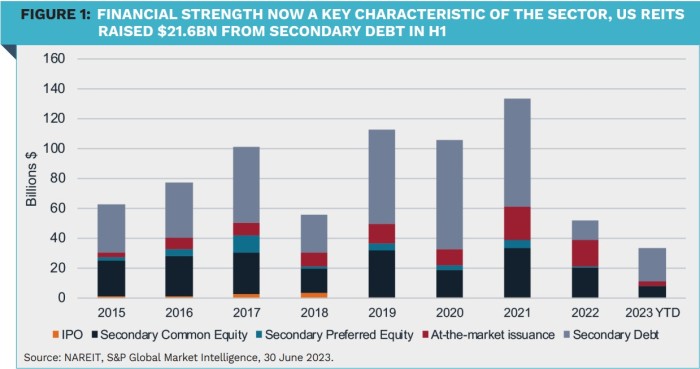Janus Henderson: Public REITs for long-term property exposure
Janus Henderson: Public REITs for long-term property exposure

Apart from relative valuation, there are other key reasons to favour public over private REITs for forward-looking investors.
By Guy Barnard, Tim Gibson and Greg Kuhl, Co-Managers Global Property Equities Strategy, Janus Henderson
This idea that public REITs are trading at a large discount to their private counterparts’ reported values has been written about extensively and is now accepted wisdom. We believe that the relative valuation gap between public and private real estate is not the most important reason to invest in public REITs today.
Aside from spot valuation, we would point long-term investors to two other factors that we think will be more important drivers of relative return between public and private real estate over the next decade.
1) In a world where money is no longer ‘free’, real estate fundamentals and operating acumen will be the primary driver of real estate returns.
In this regard, we think public REITs have a meaningful advantage over their private counterparts.
Generationally cheap debt was a very significant driver of returns for highly levered private real estate vehicles over the decade leading up to the pandemic. Some might even argue that the performance of certain private real estate funds was more about financial engineering than about real estate fundamentals over this timeframe. Conversely, public REITs spent the 2010s deleveraging their balance sheets, which was a headwind to cash flows. But US public REITs still outperformed private by around 2.0% per annum1.
How did public REITs outperform with lower leverage? In our view, public REITs outperformed private during the 2010s mainly because of superior real estate fundamentals. This includes more favourable property type exposure and stronger operating platforms that are costly, difficult to assemble, complex, and better suited to infinitelived public companies.
The majority of private real estate investment has been and remains in the core property types of office, retail, industrial, and apartments. Public REITs also offer high quality exposure to the core property types, but the majority of exposure today is to non-traditional property types like cell towers, data centres, selfstorage, senior housing, single tenant net lease and single-family rental.
Private real estate’s focus on the core property types is partly an exercise in necessity. For example, for a large private equity real estate manager, it is far more expedient to underwrite and acquire one office building for $400 million and hire a real estate services firm to manage the asset, than to underwrite and acquire 40 self-storage facilities for the same price and establish an operating platform servicing thousands of underlying tenants.

Non-traditional property takes more time to assemble into a quality portfolio and is typically more operationally intensive than core property types. This makes non-traditional property a good match for infinite-lived public companies, which can typically continuously access capital via the debt and equity markets. The core property types generally have ‘chunkier’ (higher-dollar value) individual assets, which are more conducive to the desktop underwriting and thirdparty management approach employed by private real estate. Non-core property types typically require much lower maintenance capital investment. They can benefit from more favourable supply and demand dynamics relative to the core property types, given they are more exposed to demographic and technology tailwinds, increasing the potential for better cash flow growth.
For investors who agree with our view that the next decade of real estate returns will not be driven by cheap debt, but instead by the cash flow growth of underlying properties, public REITs can be a great place to be.
2) High-quality real estate naturally flows into the strongest hands, in other words those with the best access to capital and the lowest cost of capital.
Today this is very clearly public REITs. The value of real estate compounds slowly over time: public REITs’ ability to enhance and expand their portfolios today should pay (literal) dividends over the next decade and beyond.
During the 2010s, cheap debt provided massive buying power to those investors willing to maximize financial leverage, allowing them to pay the highest prices for real estate. Over this period, the average coupon on CMBS debt (a key source of debt financing for private real estate) was 4.5%. This then declined to 3.8% during the second half of the decade. The average term on CMBS debt was five years and the average spread over a 5-year US Treasury Note was 160bps. Today (11 August 2023), the yield on a 5-year US Treasury Note is about 4.3% and the average CMBS spread over Treasuries is 237 bps, which indicates a generic CMBS coupon of 6.7%2. For office and retail assets, debt financing rates can be significantly higher than this.
What’s the impact, now that real estate faces higher debt costs?
Real estate that was financed at high loan-to-values (LTVs) in the latter half of the 2010s at coupons averaging 3.8% are likely to see a dramatic decline (or elimination) in cash flows to equity when this debt needs to be refinanced at rates of around 6.6% today.
Balance sheet pressure for private real estate owners is very real. Balance sheet stress combined with redemption queues means we are likely to see private real estate owners selling real estate to raise capital. Public REITs with generally low leverage balance sheets coupled with continuous access to the unsecured credit and equity markets are ready and waiting to take advantage of arising acquisition opportunities. We have already seen meaningful examples of this and expect there will be more to come. Real estate compounds in value slowly over time – today’s acquisitions of high-quality real estate look set to fuel increased growth in public REITs for years to come.
Conclusion
Investors willing to study the historical context of public versus private real estate portfolio construction and returns in conjunction with the very different environment that exists today may come to appreciate our point of view on the long-term investment merits of public REITs vis-à-vis their private counterparts.
A cheap valuation relative to private real estate may be the ‘sizzle’ for investing in public REITs at the moment, but the ‘steak’ comes in the form of an increasingly divergent return outlook, which public REIT investors may likely savour for years to come.
1) Bloomberg, Janus Henderson Investors 10 years to 31 December 2019. FTSE Nareit All Equity REITs Index vs NCREIF ODCE Index. Past performance does not predict future returns.
2) Bloomberg, US 5-Year Treasury Note yield; ICE BofA US Fixed-Rate Commercial Mortgage-Backed Securities (CMBS) Index OAS versus Govt, 11 August 2023.
|
SUMMARY The impact of rate rises on listed property and the resulting discrepancy between public and private REIT valuations is well known. The era of ‘free money’ is over. Real estate fundamentals and operating acumen are becoming the primary driver of real estate returns, which plays to the strengths of public REITs. Public REITs’ relatively low cost of capital leaves the asset class well positioned to take advantage of future opportunities. |
|
Disclaimer The views presented are as of the date published. This article is intended solely for the use of professionals, defined as Eligible Counterparties or Professional Clients, and is not for general public distribution. Marketing communication. Janus Henderson Investors is the name under which investment products and services are provided by Janus Henderson Investors International Limited (reg no. 3594615), Janus Henderson Investors UK Limited (reg. no. 906355), Janus Henderson Fund Management UK Limited (reg. no. 2678531), (each registered in England and Wales at 201 Bishopsgate, London EC2M 3AE and regulated by the Financial Conduct Authority) and Janus Henderson Investors Europe S.A. (reg no. B22848 at 2 Rue de Bitbourg, L-1273, Luxembourg and regulated by the Commission de Surveillance du Secteur Financier). Janus Henderson and Knowledge Shared are trademarks of Janus Henderson Group plc or one of its subsidiaries. © Janus Henderson Group plc. |










